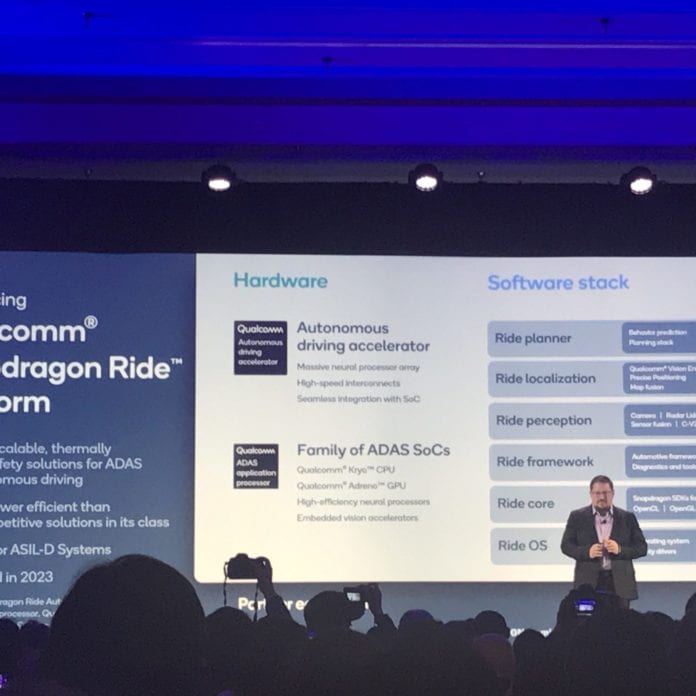Automotive OEMs: Beyond the active safety level of vehicle autonomy, the cost of the system becomes “prohibitive”
LAS VEGAS – Qualcomm’s President Cristiano Amon took to the stage at CES 2020 yesterday to confirm that this will indeed be the year of 5G and to solidify the company’s place in the automotive industry with the announcement of the new Snapdragon Ride Platform, a two-chip autonomous vehicles platform.
The Ride platform is designed to help automakers and Tier 1 suppliers achieve true vehicle autonomy faster and consists of the ADAS Application Processor chip and the Autonomous Driving Accelerator chip.
The primary SoC, or the ADAS Application Processor will support the basic level of autonomous driving, or level 1/2. Referred to as “active safety,” this level includes solutions for safety features, such as collision avoidance and blind-spot detection. Similarly, Level 2 to Level 3, or the “convenience” level, which includes solutions meant to make a driver’s life easier like autonomous parking and automated lane changing, can be achieved with a single-chip or two-chip solution using ADAS application processors.
However, according to Qualcomm’s Rajat Sagar, who oversees ADAS and autonomous product management at Qualcomm, the performance requirement for level 4+, or the truly “self-driving” level, is much more demanding. This is where the addition of the second chip comes in.
The Autonomous Driving Accelerator chip, Sagar told RCR Wireless News, “instantaneously adds a huge amount of AI performance to [a] particular level” when bolted on to any of the application processors.
“This family of processors, with ADAS SoC and autonomous driving accelerator, allows scaling to sub-30 to more than 700 TOPS (trillion operations per second),” he continued.
In this way, Qualcomm’s scalable, two-chip autonomous vehicles platform addresses a variety of needs, ranging from automatic emergency braking to traffic sign recognition to automated highway driving, just to name a few.
Further, while the platform has a full stack of hardware to software necessary to run autonomous vehicles, automakers won’t need to take every part of it as planning, perception and localization systems from different sources can be combined with the chipmaker’s product.
“We are not just bringing a hardware platform,” confirmed Sagar. “There is also an open and programmable autonomous stack, and proof of concept platforms, and a portfolio of tools for embedded testing [and] optimization.”
At the CES press conference, Amon claimed that the Ride platform is two times more efficient than recently announced rival. While he didn’t name names, it is possible he was referring to Nvidia’s four chip Drive Pegasus system, which can reportedly deliver 320 TOPS, and the recently announced Orin chip that claims 200 TOPS.
From Sagar’s perspective, what puts Qualcomm ahead of its peers is the unique insights the company has achieved into what automotive suppliers really need in the years to come. “We have a lot of understanding of what it takes to be automotive suppliers and [we] work with practically all the OEMs around the globe. We have good working relations with all of them.”
Specifically, the OEMs have expressed that due to different constraints, they are typically able to launch active safety or end cap systems at a broad scale, but beyond that, the cost of the system becomes “prohibitive.”
“The level 2 and above systems are not in a wide deployment as much as the OEMs would like and as much as the consumer demand is there.” He stated that due to the Ride Platform’s lack of liquid cooling, it consumes less power. Instead, the system can be air-cooled, potentially making for simpler and cheaper vehicle designs.
“[Our systems will] be able to enable much smaller [and more cost-efficient] form factors for OEMs,” he concluded.

